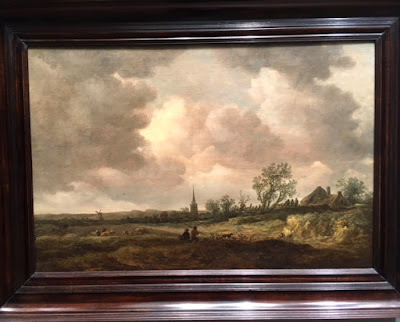23 Years Later: Allen Memorial Art Museum
The front of Allen Memorial Art Museum. The inscription reads:
"The Cause of Art is the Cause of the People." I always loved that.
Sometimes an art museum changes the course of one's life.
For the first time in 23 years I flew back to my alma mater, Oberlin College in Ohio to visit my first home as an artist, the Allen Memorial Art Museum. I arrived on campus as an awkward 18 year old freshman intending to major in Sociology. Yet I found myself returning to the Art Museum with increasing frequency as the semester progressed. The lure of the Museum's exhibits became too strong to resist. By November of my first semester I switched to majoring in Studio Art.
Philip Koch with the Dutch painter Hendrick ter Brugghen's
oil St. Sebastian Tended by Irene, 1625
Andria Derstine, Allen's Director, generously gave me a good part of her day, touring the Museum with me and filling me in on changes since my time on campus. I asked her to take my picture with what has to me my favorite piece in the collection Hendrick ter Bruggen's Saint Sebastian. That painting had always perplexed me in the way it combined a gristly subject with such a gentle feeling for light and tenderly painted surfaces. It was the painting that first made me grasp that how artists handle their medium is just as important as what they are depicting. Here's a detail of what has to be the most loving removal of an arrow.
Detail of her Brugghen's St. Sebastian Tended by Irene
I reflected that afternoon on how ter Brugghen's painting had so moved me. I realized that many of the paintings in Allen that had been my favorites had also been teachers to me. They provided critical initial lessons to my young self about what mattered in painting. The things I learned from them have stayed with me over nearly 50 years of me painting in my studio.
For example, Allen's big Frank Stella painting impressed on me how expressive bold silhouetted shapes can be. Even today when I start a new painting this is my paramount concern.
Allen's Contemporary Gallery. Left: Frank Stella, Agbatana III,acrylic,
1968, Right: Larry Poons, Away Out on the Mountain, acrylic, 1965,
Front: Eva Hesse, Laocoon, sculpture, 1966
Andrea Gyorody, the Allen's Curator of Modern and Contemporary Art gave me a guided tour of the current exhibit she put together. Entering the Contemporary Gallery one is greeted by Alice Neel's portrait of Ellen Johnson, a long time art historian on Oberlins' faculty who was responsible for much of the Museum's acquiring contemporary art. I took a class on Modernism with Johnson.
Alice Neel, Portrait of Ellen Johnson, oil, 1976
An early favorite of mine was Larry Poons' big acrylic (below). It showed me the intrinsic power of contrasting complementary colors. All mixing of pigments I do today is based on playing off complements against each other.
Larry Poons, Away Out on the Mountain, acrylic,
1965
Another painting hanging in the contemporary wing was by Richard Diebenkorn's. It graphically revealed to me how a painting can straddle the worlds of abstraction and representation.
Richard Diebenkorn, Woman by a Large Window, oil
1957
The swirling gold dress in Rubens' wonderful Baroque painting dazzled my eye with its agitated brushwork. This painting taught me that looser brushwork can energize forms and still convey firmness and solidity. Rubens inspired me to let my hand's gestures freely pulse through all the forms when I paint.

Rubens, The Finding of Erichthonius, oil, 1632-33
The detail below of one of my oils of a house that Edward Hopper once painted shows that characteristic loose paint handling,

Detail of Philip Koch's Morning at the Route 6, Eastham House,
oil, 2016, Swope Art Museum, Terre Haute, IN.
Joseph Wright of Darby, Dovetail by Moonlight, oil, 1784-85
Joseph Wright of Darby's exploration of light effects, like the shimmering moonlight here, got me thinking about what can happen when an artist plays around with light conditions. I had always admired that image and had it in mind when I painted this nocturne below.
.
Philip Koch, The Reach IV, oil, 40 x 60 inches, 2011
I also got to see another old favorite by the Dutch painter de Witte with its enticing play of warm and cool highlights on the walls of this church.
Emanuel de Witte, Interior of the Old Church at Delft,
oil, 1653-55
I remember that painting spurred my own interest in painting interior spaces, including the long series of oils I've made during my residencies in Edward Hopper's studio on Cape Cod.
Philip Koch, Rooms by the Sea: September II, oil,
28 x 42 inches, 2017
Wolfgang Stechow, the Oberlin art historian who was an expert on northern baroque landscape painting, helped the Allen acquire some world class landscape paintings. Those canvases gave me a powerful nudge towards working from the landscape. Here are some favorites I saw again last week.

Above: John Frederick Kennett, Mt. Mansfield from Malletts Bay,
Lake Champlain, oil 1860, Below: Thomas Cole, Lake with Dead
Trees (Catskill), oil, 1825
Meindert Hobbema, A Pond in the Forest, oil, 1668
Jan van Goyen, Landscape with Dunes, oil, 1647
In each of those paintings the artists found visual means to knit together the land and the sky. My painting Inland shows some of the debt I owe the Allen landscapes.
Philip Koch, Inland, oil, 45 x 60 inches, 2008
Allen Art Museum's interior court. Note the natural light filtering down from the clearstory windows.
P.S. Allen is going to open a major exhibition of Rembrandt's etching Feb. 6 - May 13, 2018, borrowing works from many major museums. Sure to be terrific.

















